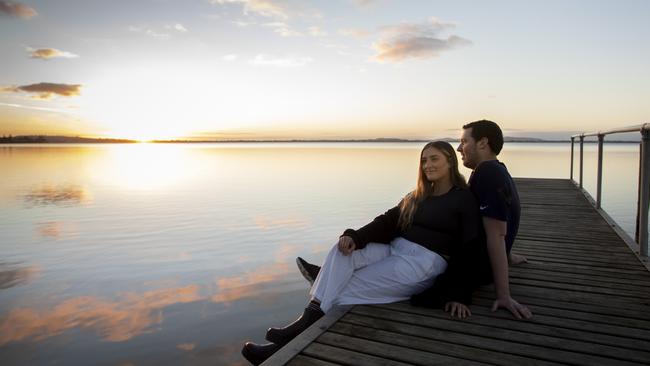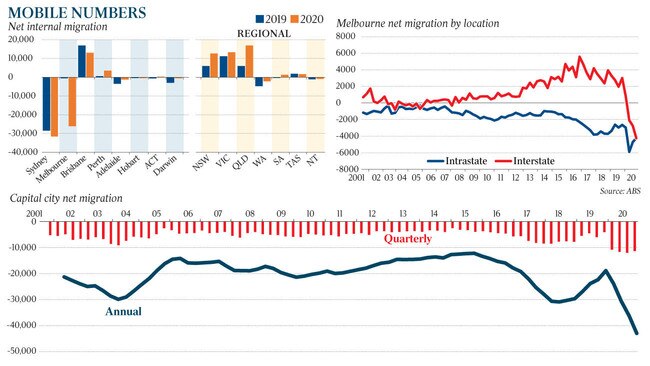Regions see ‘biggest’ net inflow in decades as Australians flock from cities
Stats show COVID-19 lockdowns sparked a lifestyle rethink for thousands of Australians.

Migration to the country’s regions surged last year to its highest point since records began two decades ago, as the pandemic shifted Australians’ views on where they want to live.
Australian Bureau of Statistics figures show almost 43,000 more people moved to regional areas from cities in 2020 than shifted the other way — and net migration to Melbourne from other states fell off a cliff as the nation’s largest centres struggled with the pandemic and on-again, off-again restrictions.
Regional migration figures reveal 223,100 Australians moved from capital cities to live in regional areas in 2020, while 190,200 went in the opposite direction. The net shift to regions was more than twice the 18,900 recorded in the previous year.
The shift to the regions — most pronounced in Queensland (with a net inflow of 17,000 people), followed by Victoria (13,400) and NSW (12,700) — has already had a pronounced impact on property prices, according to real estate analysts at CoreLogic.
“Some of the most substantial uplift in values over the 12 months to April have been across lifestyle markets such as the Richmond-Tweed market (up 20.7 per cent), the southeast of Tasmania (up 19.6 per cent), the Southern Highlands and Shoalhaven market (up 19.2 per cent) and the Sunshine Coast (up 16.6 per cent),” said Eliza Owen, CoreLogic’s head of research. “Dwelling values in the 12 months to April have lifted more substantially across the combined regional housing market (by 13 per cent) compared with a 6.4 per cent lift across the combined capital cities market.”
Most of the drift to the regions came from Sydney — with a net outflow of more than 31,000 — though a net 26,000 also moved out of Melbourne, the largest on record for the city, the ABS data reveals. And with overseas migration coming to a halt amid COVID-19 travel restrictions, this is a concern for the economies of the two big capitals.
Melbourne has been losing people to Victoria’s regional areas for the past 20 years, and in more significant numbers since 2016, but the net loss interstate is a significant demographic change, with 12,700 more people leaving Melbourne for homes in other states last year than arriving.
“We are talking about net numbers here, so this is a combination of people moving out of Melbourne but also people not going there to live,” Australian National University demographer Peter McDonald said.
“COVID and the lockdown were no doubt a part of that.
“There would be students who had planned to study in Melbourne last year who didn’t come, and other workers who would have moved interstate for job opportunities couldn’t in a year when there was such disruption.”

Sarah Collins and partner Max Bannan, both 22, moved in February from Melbourne to Colac, a town of 12,000 people, 150km southwest of the Victorian capital.
“I used to work in (Melbourne) at a law firm and moved down here with my boyfriend in February,” Ms Collins said.
“He is from around here. I think from seeing the difference between his lifestyle growing up here compared to what I had in the suburbs … the whole town grows up together.
“I look at the kids around here and think I’d love my kids to experience what I didn’t have.”
After they survived the pandemic and lockdown last year, Ms Collins, now a law clerk at a local Colac firm, said the couple decided to buy a block of land 10 minutes away from the town.
“We love the bush life. I’m swapping my high heels for my gumboots,” she said.
Regional Australia Institute chief executive Liz Ritchie said the data showed while outflows from capital cities to the regions were up 5 per cent in December 2020 compared to the same quarter in 2019, “the bigger influence was regional people staying in the regions and choosing not to move to a capital city. It is likely the rise in the number of regional Australians staying put … is having an impact on regional rental vacancy rates and the stock of housing for sale,” she said. “With people staying put, there will be less opening of rental vacancies for newcomers and less housing for sale.”







To join the conversation, please log in. Don't have an account? Register
Join the conversation, you are commenting as Logout